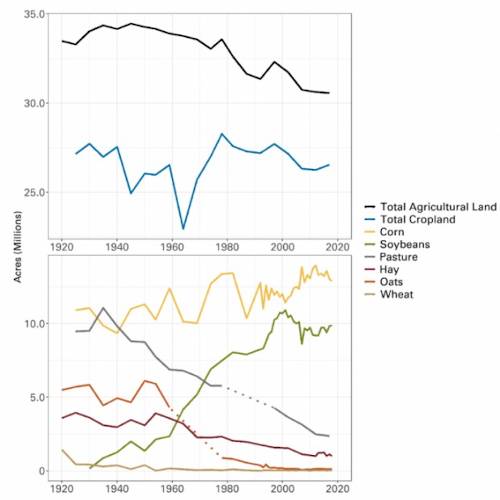By Laurie Nowatzke
An ongoing public concern is the loss of nutrients from agricultural land in the corn belt. In Iowa, nitrogen and phosphorus losses from farm fields are driven by a variety of factors. Since the mid-twentieth century, statewide corn and soybean acres have increased as extended rotations, hay, and pasture declined. Compared to perennial crops and small grain rotations, corn-soybean and continuous corn rotations are leaky systems. They require increased fertilizer rates creating vulnerability to nutrient loss, have a lower capacity for capturing and holding nitrogen (N) during wet conditions, and lack surface cover to prevent soil erosion and phosphorus (P) loss during heavy rain events. These nutrient losses contribute to local stream and river impairments, create challenges for small communities in maintaining safe nitrate levels in drinking water, and add significantly to the size of the dead zone in the Gulf of Mexico.

Figure 1. Agricultural land use over time in Iowa. Data: United States Department of Agriculture National Agricultural Statistics Service.
Addressing nutrient loss in Iowa agriculture
To address Iowa’s nutrient contributions to the Gulf hypoxic zone, the Iowa Nutrient Reduction Strategy (INRS) established goals for reducing N and P loss from agricultural nonpoint sources by 41% and 29%, respectively. The INRS Science Assessment identified a number of conservation options that reduce N and P loss ranging from in-field fertilizer and soil management practices to strategic conversion of row crop acres to perennial systems. The INRS identifies these practices as follows.
- In-field practices – annual management practices including cover crops, reduced and no-tillage, and fertilizer management.
- Edge-of-field and erosion control practices – structural practices or vegetation that prevent nitrate and/or eroded soil from leaving the field and entering nearby surface water or subsurface drainage. These practices include bioreactors, saturated buffers, terraces, and nutrient removal wetlands.
- Land use change – practices that incorporate additional crops or convert row crops to perennial vegetation. These practices include extended rotations, conversion to pasture or prairie, and perennial bioenergy crops.
The current status of conservation in Iowa
The Iowa Nutrient Reduction Strategy Annual Report is published each year to document the change in statewide efforts toward meeting the INRS goals, including acres of various conservation practices such as cover crops, tillage, bioreactors, and more. Below are some of the findings of that assessment.
- Cover crops planted in Iowa increased from 379,000 acres in fall 2011 to 973,000 in fall 2016, according to the newly available 2017 United States Department of Agriculture (USDA) Census of Agriculture.
- Based on the USDA Census of Agriculture, annual corn and soybean planted acres have remained relatively consistent since the 1980s, with some fluctuation. Preliminary analyses of the USDA Cropland Data Layer suggest that perennial agricultural acres – including pasture, hay, and acres enrolled in CRP – have decreased over time, with approximately 4.3 million acres in 2018.
- No-till acreage increased from 6.9 million acres in 2012 to 8.2 million in 2017, according to the Census of Agriculture.
- By the end of the 2018 calendar year, there were an estimated 27 bioreactors and 13 saturated buffers installed through cost-share programs, treating an estimated 2,000 acres or more.
- Iowa has 86 nitrate-removal (i.e., CREP) wetlands that treat 107,000 acres. An additional 30 wetlands are currently under development for completion in the coming years.
- Since 2011, approximately 22.5 million feet of terraces have been constructed using state cost-share funds. These terraces treated 174,000 acres of land and reduced P losses by 40 tons in 2018.
Moving forward
Meeting the goals of the INRS requires changes on every acre of Iowa farmland. One scenario calls for an estimated 10.5 million acres of no-till and strip-till, 12.5 million acres of cover crops, 7,600 nutrient removal wetlands, and 120,000 bioreactors and saturated buffers. In comparing these numbers to the 2019 assessment of practices, we have a lot of work ahead us to reach the goals. Numerous resources and technical and financial assistance programs are available to assist farmers, landowners, and their advisers select, implement and manage conservation practices successfully.
Tools for getting started
With a range of conservation practice options to choose from, it can be difficult to decide which practice(s) is right for you and where to start. The Conservation Systems Best Practices Manual and decision support tools were developed with these challenges in mind to help farmers, landowners, and their advisers make sound decisions and have successful conservation practice implementation experiences. The manual outlines recommendations for in-field and edge-of-field practices including cover crops, no-till, strip-till, multi-year crop rotations, prairie strips, bioreactors, saturated buffers, and nutrient removal wetlands. The manual was developed using a cropping systems approach and includes planting, nutrient management, pest and disease management, and harvest tips and considerations for the in-field practices. Download the free manual from the ISU Extension Store website.
Financial incentives
To help offset the cost of getting started, the statewide cost-share program through the Iowa Department of Agriculture and Land Stewardship Water Quality Initiative Program is offering $25 per acre for first time cover crop farmers and $15 per acre for farmers who have tried cover crops in the past. First time no-till or strip-till adopters are eligible for $10 per acre and farmers using nitrapyrin nitrification inhibitor with fall fertilizer are eligible for $3 per acre. Funding is limited to a maximum of 160 acres per farmer or landowner. Applications can be submitted through your local Soil and Water Conservation District office.
Source : iastate.edu